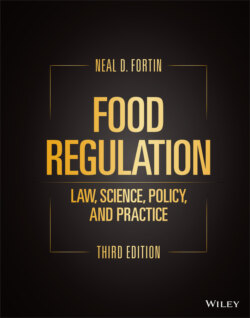Читать книгу Food Regulation - Neal D. Fortin - Страница 137
NOTES AND QUESTIONS
Оглавление1 3.22 The credulous consumer versus the ordinary, reasonable consumer. What type of consumer was considered in the Diet Thins case in determining what is misleading? In contrast, other courts have applied an “ordinary consumer” or “ordinary, reasonable consumer” standard. See, e.g., United States v. 88 Cases, Bireley’s Orange Beverage, 187 F.2d 967, 971 (3d Cir.) (noting that the FD&C Act § 403(f) states that “the branding must be such as is ‘likely to be read and understood by the ordinary individual under customary conditions of purchase and use’ … We think that essentially the same standard should be applied to the determination of consumer reaction under both sections.”). Also, see below, United States v. 174 Cases Delson Thin Mints, 287 F.2d 246 (1961).
2 3.23 FDA’s policy on consumer capacity. In 2002, FDA declared that the agency would use a “reasonable consumer” standard to determine whether food labeling is misleading, explaining, “The reasonable consumer standard more accurately reflects FDA’s belief that consumers are active partners in their own health care who behave in health promoting ways when they are given accurate health information.” 67 Fed. Reg. 78002‐78004 (Dec. 20, 2002).
3 3.24 FTC’s policy on consumer capacity. FTC has applied a similar standard by policy since 1984. See 103 FTC 100, 174 (1984) (“from the perspective of a consumer acting reasonably in the circumstances.”) Only “a significant minority of reasonable consumers” need to be deceived for the practice to be deemed misleading. Id. note 20.
4 3.25 Reasonable consumer versus not misleading “in any particular.” How can you reconcile the tension between the reasonable consumer standard and not misleading in any particular?
5 3.26 The gullible consumer as the ordinary consumer. Are there situations where a gullible consumer might be the ordinary consumer?
6 3.27 Compliance with the FD&C Act no bar to Lanham Act claims. In POM Wonderful LLC v. Coca‐Cola Co., 134 S.Ct. 2228 (2014) the court held that a statutory private right of action under the Lanham Act is not precluded by compliance with the regulatory provisions of the FD&C Act. In effect, the FD&C Act and the Lanham Act are complementary, and the FD&C Act and its regulations do not provide a ceiling on Lanham Act claims. Neither statute forbids Lanham Act claims on labeling regulated by the FD&C Act, and the statutes have coexisted for seventy years. See Chapter 19 for more of this case.
